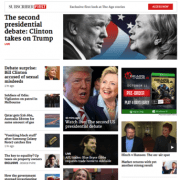How hard can it be?? The transition from print to digital
The two leading Fairfax Media properties for decades were The Age and The Sydney Morning Herald. And didn’t advertisers know it.
Often referred to as being ‘rivers of gold’ the spend on advertising in their voluminous publications were the stuff ad rep’s dreams are made of.
That was then. Now, both papers have been reduced to wafer thin tabloid-sized weekday editions with virtually no advertising and barely a page of classifieds or public announcements.
There could be no better demonstration of Fairfax’s fall from grace than the post AFL Grand Final edition of The Age. Made up of only 40 pages, 13 of which were sport, and carrying only two half page colour ads.
So how hard could it have been to get so few ads right? Apparently too hard. The Age ran an ad from Western Bulldogs supporters, University of Victoria, congratulating them on a fine season and a great effort despite not winning the flag.
Notice anything unusual? The Age’s ad department clearly did not.
One mistake isn’t the be-all-and-end-all but it’s not just one mistake. Industry insiders tell us that there is a constant stream of similar mistakes that, in most cases, are only picked up once the client or agency puts in a call.
Fairfax has all but given up the ghost on print and, it would appear, allocated resources elsewhere. They are focussed on online content but even there questions abound. The content deal with the Huffington Post has opened them to the accusation of becoming nothing much more than ‘click-bait’ focussed. And the recently revamped online editions for the leading mastheads do little to disprove that theory.
Fairfax’s mismanagement of the transition to digital has left fertile ground for more agile competitors. Witness the arrival of The Guardian with a digital only Australian edition.
Companies and organisations are faced with an increasingly segmented media landscape. There is now a combination of online ‘broadcasters’ and digital ‘narrowcasters’ that businesses need to work with in order to get their messages through to their target audience. A ‘publish and pray’ media release will not do the job. Actually, it never really did.
It is a rapidly changing and evolving media environment and RMK+A harnesses its media expertise to continually review the risks and opportunities for its clients’ media engagement needs.




